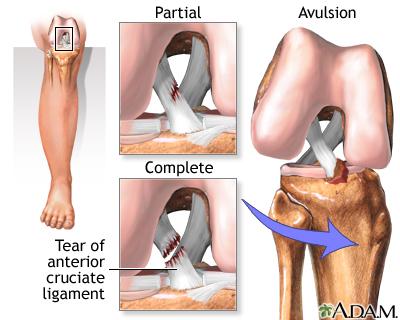
Anterior Cruciate Ligament Injuries
Overview
The anterior cruciate ligament (ACL) is one of the key ligaments in your knee. An ACL injury is a common knee injury and the prevalence is particularly high among athletes who participate in high-demand sports like soccer, football, and basketball.
Types
There are mainly three types:
-
- Grade I Sprains: Mild damage to the ACL. It’s slightly stretched, but still able to help keep the knee stable.
-
- Grade II Sprains: The ACL is stretched to the point where it becomes loose. This is often referred to as a partial tear.
-
- Grade III Sprains: Most commonly referred to as a complete tear of the ACL. The ligament has been split into two pieces, rendering the knee unstable.
Causes
Most ACL injuries happen during sports or fitness activities that can put stress on the knee:
-
- Sudden change in direction (cutting or pivoting)
-
- An awkward landing from a jump
-
- A blow to the side of the knee, such as during a football tackle
Symptoms
If you’ve injured your ACL, you might hear a “pop” sound and may feel your knee give out from under you. Other common symptoms include:
-
- Pain with swelling. Knee swells within the first few hours of injury.
-
- Restricted range of motion.
-
- Tenderness along the joint line.
-
- Discomfort while walking.
Diagnosis
Your doctor will usually be able to diagnose an ACL injury through a physical examination. In some cases, an MRI or ultrasound might be used to get a more detailed look at the knee.
Treatment Options
The best treatment depends on the individual’s needs. Options include:
-
- Physical Therapy: Strengthening the muscles around the knee to restore its full function.
-
- Surgery: If the knee is unstable, surgery might be recommended to replace the ACL.
-
- Medication: Pain relievers or anti-inflammatories.
Living With Anterior Cruciate Ligament Injuries
Living with an ACL injury requires discipline and lifestyle changes.
-
- Exercise: Regular exercise to strengthen your knee and improve flexibility.
-
- Lifestyle Changes: Weight loss and low-impact exercises can be beneficial.
-
- Medication: Managing medication per your doctor’s instruction for pain and swelling.
When to Seek Help
If you’re experiencing knee pain and swelling, instability in your knee, or are unable to bear weight on your affected leg, seek medical attention immediately. Ignoring these symptoms may lead to further damage.
